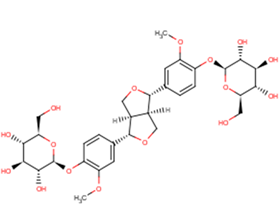
Pinoresinol diglucoside
CAS No. 63902-38-5
Pinoresinol diglucoside( —— )
Catalog No. M18941 CAS No. 63902-38-5
Pinoresinol diglucoside is a putative α-glucosidase inhibiting compound. 2. Pinoresinol diglucoside is a important antihypertensive compound.
Purity : >98% (HPLC)
 COA
COA
 Datasheet
Datasheet
 HNMR
HNMR
 HPLC
HPLC
 MSDS
MSDS
 Handing Instructions
Handing Instructions
| Size | Price / USD | Stock | Quantity |
| 5MG | 41 | In Stock |


|
| 10MG | 73 | In Stock |


|
| 50MG | 263 | In Stock |


|
| 100MG | 478 | In Stock |


|
| 200MG | Get Quote | In Stock |


|
| 500MG | Get Quote | In Stock |


|
| 1G | Get Quote | In Stock |


|
Biological Information
-
Product NamePinoresinol diglucoside
-
NoteResearch use only, not for human use.
-
Brief DescriptionPinoresinol diglucoside is a putative α-glucosidase inhibiting compound. 2. Pinoresinol diglucoside is a important antihypertensive compound.
-
DescriptionPinoresinol diglucoside is a putative α-glucosidase inhibiting compound. Pinoresinol diglucoside is a important antihypertensive compound.
-
In Vitro——
-
In Vivo——
-
Synonyms——
-
PathwayOthers
-
TargetOther Targets
-
Recptorα-glucosidase
-
Research AreaOthers-Field
-
Indication——
Chemical Information
-
CAS Number63902-38-5
-
Formula Weight682.67
-
Molecular FormulaC32H42O16
-
Purity>98% (HPLC)
-
SolubilityIn Vitro:?DMSO : 100 mg/mL (146.48 mM)
-
SMILESCOC1=C(C=CC(=C1)C2C3COC(C3CO2)C4=CC(=C(C=C4)OC5C(C(C(C(O5)CO)O)O)O)OC)OC6C(C(C(C(O6)CO)O)O)O
-
Chemical Name——
Shipping & Storage Information
-
Storage(-20℃)
-
ShippingWith Ice Pack
-
Stability≥ 2 years
Reference
molnova catalog



related products
-
PM 102
Peptide that reverses the anticoagulant effect of heparin. Potently binds heparin (Kd = 36 nM in vitro).
-
(S)-1,2,3,4-Tetrahyd...
1-Tetralol, (S)- can be used as a substrate of AKR1C1 in cell assays.
-
Demeton-s-methyl sul...
Demeton-S-methyl Sulfone is a kind of pesticides.



 Cart
Cart
 sales@molnova.com
sales@molnova.com


